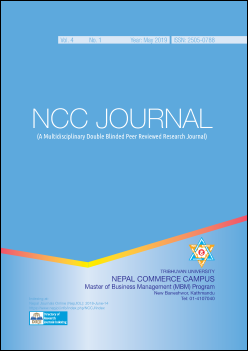Personal Income Tax Structure in Nepal: An evaluation
DOI:
https://doi.org/10.3126/nccj.v4i1.24739Keywords:
Inclusions, deduction, exemption, taxpayer unit, tax base, tax slab tax rate, tax burdenAbstract
Purpose – This paper aims to evaluate the structure of the PIT in Nepal.
Methodology/design/approach –This study adopts descriptive and quantitative research approach, sourcing the data and information from both primary and secondary, which include books, reports (economic survey, report/statement of Central Bureau of Statistics, etc.), journals, bulletins, newspapers, websites, etc. For the objective result, we use statistical tools to confirm the value of the PIT structure.
Findings and conclusion – The PIT is a major ingredient of income tax, which contains a complex and critical structure in income components, exemption limit, tax base, units, and tax rates. The study found increment in the exemption limit based on equity, equality and with the rate of inflation. However, the method of determination of exemption limit was unscientific. The tax slabs and rates observed three categories progressive, digressive and mild progressive under the three governments regimes inconsistent with national tax policy. Different era of government imposed the tax burden on different slabs and observed decline in tax progressivity in the later year. In the studied period, the PIT payers sacrificed27.81% amount as tax and saved only 72.19% of their total taxable net earnings. It showed a high rate of tax. The tax burden on PIT reached as high as 45.49%in 1989-90 and as low as 24.13% in 1998-99. The gap between maximum and minimum ranged 22.89%, with a great disparity in the tax policy and an average tax, the burden remained 32.56% during the studied period. A high rate of tax encourages the evasion; taxpayers alter their decisions on the financial activities, which reduce the benefit of both the public authorities and taxpayers or citizens. Good tax policy should strive to provide benefit to both the concerned parties.
Originality/value – This is descriptive research to find out the structure of Piton Nepal, which is derived and written by the author using the primary as well as secondary sources of data and information. Thus, this is original writing in the context of Nepal and in PIT literature.
Downloads
Downloads
Published
How to Cite
Issue
Section
License
© Nepal Commerce Campus, Tribhuvan University
CC BY-NC: This license enables reusers to distribute, remix, adapt, and build upon the material in any medium or format for noncommercial purposes only, and only so long as attribution is given to the creator.




